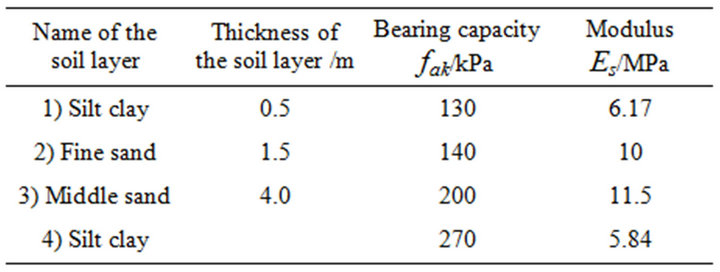The Dynamic Characteristic Experimental Method on the Composite Foundation with Rigid-Flexible Compound Piles ()
1. Introduction
The composite foundation is that the part body in the natural ground foundation is reinforced or replaced during the ground treatment, and load is born by reinforced body and soil around pile [1]. The composite foundation with multi-type compound piles are formed by two and more than two kinds of piles. The design methods of the single-type-pile composite foundation have relatively ripe experience, and those of multi-type composite foundation are not perfect. With the rapid development of the economy, the strength, length and bearing capacity of the composite foundation have great enhanced. The original design theories do not meet the needs of design, and dynamic problems of composite foundation also become the concern hot point. It is necessary to introduce antiseismic design on the composite foundation. The dynamic studies of the composite foundation mainly concentrated on the numerical simulation applied finite element method software [2-4]. The dynamic characteristic and its effect factors of CFG pile and CS pile composite foundation were studied by in-site test of demolitions [5,6]. Due to the restriction of the demolitions, the site dynamic characteristic tests of the composite foundations are made by using fireworks bomb as driven vibration to replace demolition.
2. The Introduction of the Test Site
The test site is located in Shijiazhuang Heibei province. In the 20 m depth, the soil layers mainly are yellow silt clay, fine sand, middle sand and silt clay. In the 20 m driving depth, the underwater is not seen. There is not the harmful geologic action in the site. The main parameters of soil layer as shown in Table 1.

Table 1. The main parameters of soil layer of the test site.
3. Model Test and Scheme of the Site
The three types of the composite foundation model are designed. There are CFG piles, CFG long piles and CS short piles, and CS piles with CFG core as well. The design parameters of the composite foundation are shown in Table 2. The arrangement of the piles and measuring elements of the composite foundation with CFG long piles and CS short piles are shown in Figure 1, those of the composite foundation with CS piles with CFG core are shown in Figure 2, and those of the composite foundation with CFG piles are similar Figure 2. The CFG piles are made by concrete C20, the ratio of the cement and soil of the CS piles is 1:7. The fireworks bomb is used as vibration recourse. The vibration is picked by acceleration sensors.
4. Analysis on the Dynamic Characteristic of the Composite Foundation
Through the in-site dynamic characteristic tests of the composite foundation, the dynamic characteristic and its effect factors are studied to supply the theoretical basis of the anti-seismic design.
4.1. Vibration Acting Time
The four measuring points are arranged along pile body and one measuring point on the soil between the piles. Every measuring point is differently arranged horizontal and vertical acceleration sensors. The horizontal distance of vibration resources is differently 3 m and 8 m at a distance from of the edge of the composite foundation, and the vertical distance is 4.5 m. The typical accelerationtime curve is shown in Figure 3. The vibration acting time is about 1.0 sec. The vibration signals are more remarkable.
4.2. The Main Frequency of Vibration
Figure 4 is the typical curves of FFT analysis when the vibration resource is 3 m at a distance from of the edge of the composite foundation with CFG long piles and CS short piles. Through the FFT analysis, the main frequencies of the vibration of the measuring points are shown in Tables 3 and 4. The measuring results show that main frequency of the horizontal vibration is at 22.476 - 56.436 Hz, and main frequency of the vertical vibration is at 15.538 - 55.884 Hz.